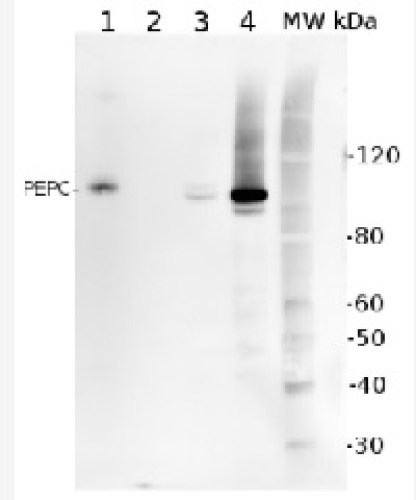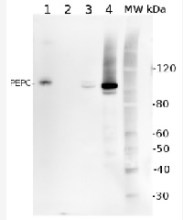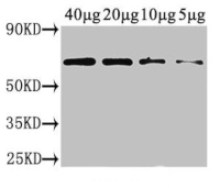
Anti-PEPC | Phosphoenolpyruvate carboxylase
(Cat#: AS09 458)


Description
- Immunogen: KLH-conjugated synthetic peptide well conserved PEPC1 and sequences from different plant species including Arabidopsis thaliana Q9MAH0, At1g53310 (PEPC 1), Q84VW9, At3g14940 (PEPC 3). The peptide chosen to elicit this antibody is also perfectly conserved in bacterial type of this enzyme NP_177043.2 (PEPC 4). For Zea mays, the peptide is converved in PEP1 and PEP4 isoforms.
- Host: Rabbit
- Clonality: Polyclonal
- Purity: Immunogen affinity purified serum in PBS pH 7.4.
- Format: Lyophilized
- Quantity: 50 µg
- Reconstitution: For reconstitution add 50 µl of sterile water
- Storage: Store lyophilized/reconstituted at -20°C; once reconstituted make aliquots to avoid repeated freeze-thaw cycles. Please remember to spin the tubes briefly prior to opening them to avoid any losses that might occur from material adhering to the cap or sides of the tube. Please do not re-use this primary antibody solution. In case of cyanobacterial samples there will be no signal in your second incubation.
- Tested applications: Immunolocalization (IL), Western blot (WB)
- Recommended dilutions: 1 : 500 (IL), 1: 1000 - : 10 000 (WB)
- Expected | apparent MW: 110 | 105 kDa
- Confirmed reactivity: Ananas comosus, Arabidopsis thaliana, Cenchrus ciliaris, Chenopodium quinoa, Chloris gayana, Chromera velia, Cyanthobasis fruticulosa, Glycine max, Hordeum vulgare, Jatropha curcas, Kochia prostrata, Leptochloa fusca, Lupinus sp. , Megathyrsus maximus, Mesembryanthemum crystallinum, Nicotiana tabacum, Oryza sativa, Panicum antidotale, Panicum coloratum, Petrosimonia nigdeensis, Pinus strobus, Saccharum spp. hybrid clone C91-301, Salsola lanata, Salsola laricifolia,Salsola grandis, Salsola tragus Sorghum bicolor, Synechocystis PCC 6803, Phaeodactylum tricornutum (strain CCAP 1055/1), Pinus strobus, Thalassiosira weissfloggi, Zea mays, Zostera muelleri
- Not reactive in: Methanothermobacter thermautotrophicus
- PEPC (phosphoenolpyruvate carboxylase), EC=4.1.1.31, belongs to an enzyme family of carboxy-lyases that is catalyzing adding fo carbon dioxide to phosphoenolpyruvate (PEP) to form oxaloacetate. Alternative names: PEPCase 1, PEPCase 3, PEPC 1, PEPC 3
- Fang et al. (2024). Subfunctionalisation and self-repression of duplicated E1 homologues finetunes soybean flowering and adaptation. Nat Commun. 2024 Jul 23;15(1):6184. doi: 10.1038/s41467-024-50623-3. Nguyen et al.(2024). The processed C-terminus of AvrRps4 effector suppresses plant immunity via targeting multiple WRKYs.J Integr Plant Biol. 2024 Jun 13.doi: 10.1111/jipb.13710. Cruz et al.(2023). Variation of photosynthesis along the canopy profile of sugarcane and energy canes. Research Square; DOI: 10.21203/rs.3.rs-3124093/v1Luo, et al. (2023) Deubiquitinating enzymes UBP12 and UBP13 stabilize the brassinosteroid receptor BRI1. EMBO Rep. 2022;23(4):e53354. doi:10.15252/embr.202153355Durall et al. (2021). Production of succinate by engineered strains of Synechocystis PCC 6803 overexpressing phosphoenolpyruvate carboxylase and a glyoxylate shunt. Microb Cell Fact. 2021 Feb 8;20(1):39. doi: 10.1186/s12934-021-01529-y. PMID: 33557832; PMCID: PMC7871529.Wang et al. (2021). Brassinosteroids inhibit miRNA-mediated translational repression by decreasing AGO1 on the endoplasmic reticulum. J Integr Plant Biol. 2021 May 21. doi: 10.1111/jipb.13139. Epub ahead of print. PMID: 34020507.Rakhmankulova et al. (2021) Possible Activation of ?3 Photosynthesis in ?4 Halophyte Kochia prostrata Exposed to an Elevated Concentration of ??2. Russ J Plant Physiol 68, 1107–1114 (2021). https://doi.org/10.1134/S1021443721060169Durall et al. (2020). Increased ethylene production by overexpressing phosphoenolpyruvate carboxylase in the cyanobacterium Synechocystis PCC 6803. Biotechnol Biofuels. 2020 Jan 28;13:16. doi: 10.1186/s13068-020-1653-y.
- Antibody can be also used following 2D gel electrophoresis
Boca Scientific is your premiere source for high-quality, innovative solutions for Cell Biology, Molecular Biology, Immunology, genetics and other lab products and reagents. We bring leading-edge products from our own-line and around the world to laboratories in the US and Canada. Our goal is to offer excellent solutions to drive research and discoveries backed by superior customer support.



